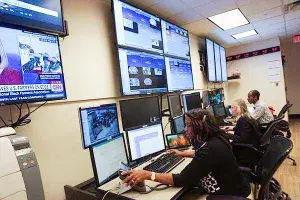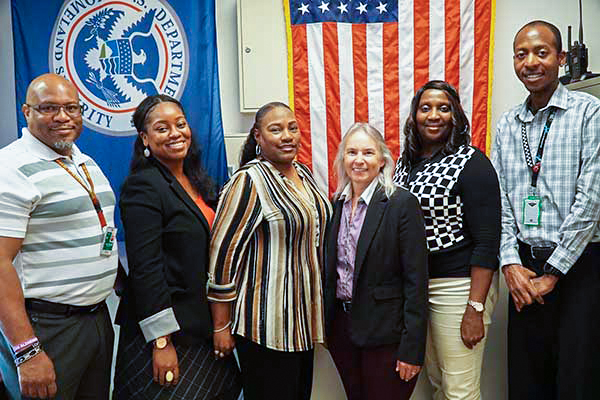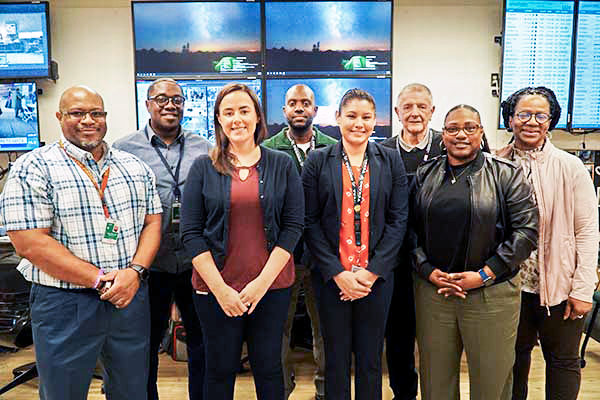
Airport checkpoints and baggage areas are known as the center of protecting our nation’s air travelers, although one part of TSA that often gets overlooked is our coordination centers.
Coordination centers keep a close eye on our airports and possible threats by gathering, analyzing, and evaluating data inside and outside airports. You could say coordination centers are airports’ watchful eyes.
“The coordination center stays abreast of events happening around the country and the world that could impede local operations,” described DeAhlmon Biglow, a coordination center officer (CCO) at Houston’s George Bush Intercontinental Airport (IAH).
“Coordination centers interact with airports throughout the nation to alert and notify each other of high profile incidents and to report potential patterns and trends of threats to aviation and the traveling public,” IAH Supervisory CCO Marissa Borrego said. “[We] wear a multitude of hats from emergency management to report writing to system auditing to incident management. Our main role is to keep the federal security director, deputy federal security director and headquarters abreast of any situations that may impact the airport and ensure all lines of communication are flowing from department to department.”
CCO Amber Bedard explained, “If an incident was discovered after a passenger departed IAH, but that passenger was set to arrive at Chicago’s O’Hare International Airport, our two coordination centers would communicate and potentially work that incident together.”

Bedard said CCOs are essential to safeguarding America’s transportation security systems as they help with checkpoint operations and communicate with senior TSA leadership and various stakeholders at her airport.
Coordination centers, like the one in Houston, are set up like a command center with work stations that overlook a series of CCTV monitors. “With CCTV at all of the checkpoints, baggage areas and lobbies, we are able to monitor most activities in the airport,” said Biglow. “The IAH Coordination Center has flight boards where we are able to monitor flight delays or cancellations. We also have two TVs – one that stays on the local and world news and the other that stays on the Weather Channel.”
Sixteen officers staff the center in Houston and cover the overnight operations for Houston’s smaller William P. Hobby Airport.
“If an incident poses a threat to any area of IAH, we would send out what we call a situational awareness, which is a summary of the incident, and updates senior leadership on what is taking place,” Bedard explained. “If the event poses immediate danger, we would stand up a bridge line with senior leadership to discuss what needs to be done. We also coordinate with the Transportation Security Operations Center (TSOC

When asked about the biggest challenge, Borrego said coordination centers couldn’t operate without electricity, phone and intranet connection. “Without the coordination center, our operations would be greatly impacted,” said Borrego. “As a result, the coordination center has established designated locations where we can pack up our workstations and equipment and set up temporary operations with minimal impact.”
Coordination centers are also essential when bad weather strikes.
“The coordination center has to stay prepared and ready at all times for any disaster, including severe weather,” said Biglow. “The weather event that gained national attention in Houston most recently was Hurricane Harvey, which was a Category 4 hurricane in August 2017 and caused catastrophic flooding and many deaths. The IAH Coordination Center worked around the clock accounting for our employees and trying to assist and gather information from employees impacted by the storm.”
Borrego, Bedard and Biglow all take great pride in what they do.
“I would not be the well-rounded leader I am today without working as a CCO,” said Borrego. “The position connects all the dots from the checkpoints, human resources, the TSOC and beyond when handling situations and events.”
“We work well together, even when there are multiple incidents and tasks,” Bedard noted. “I have served as a detailed officer in the coordination center for a little over a year and have learned so much about the daily operations of IAH.”
“I take great pride in serving my country in this aspect,” added Biglow, “and truly believe in the motto ‘Not On Our Watch.’”
